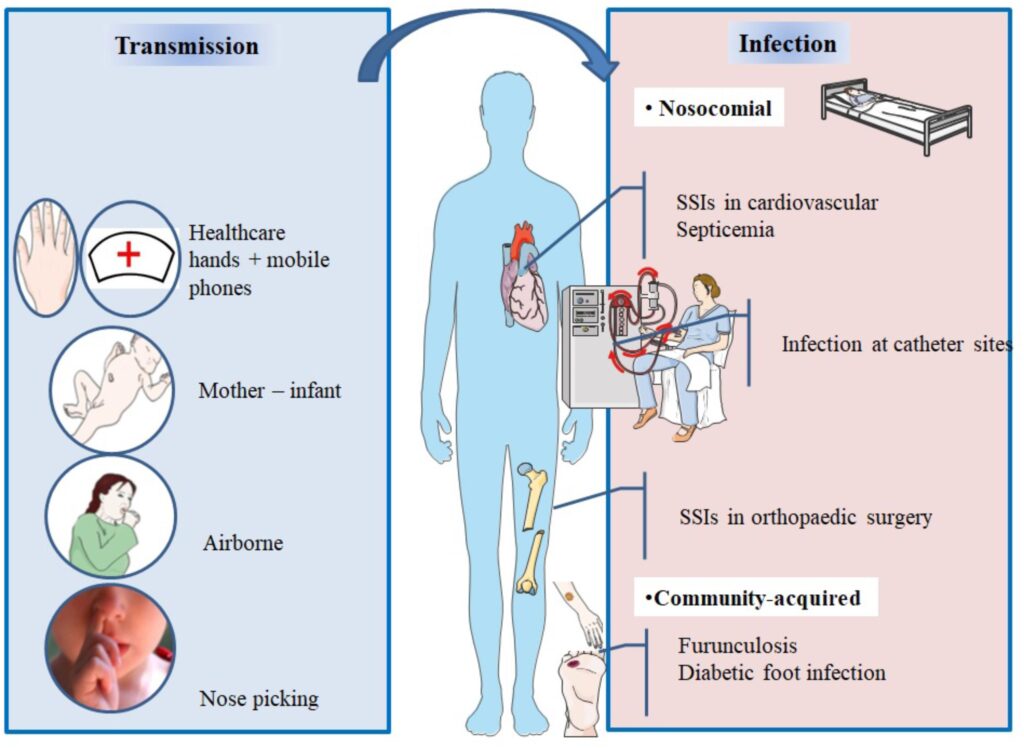Staph infections, caused by bacteria known as Staphylococcus, are among the most common bacterial infections worldwide. These infections can range from mild skin irritations to life-threatening conditions if left untreated. Understanding the types, causes, symptoms, and treatments of these infections is crucial for effective prevention and management.

What Are Staphylococcus Bacteria?
Staphylococcus bacteria are a group of microorganisms that commonly reside on the skin and in the nasal passages of humans. While they are typically harmless, certain strains can cause infections when they enter the body through cuts, wounds, or other openings. These bacteria thrive in warm, moist environments and can spread easily through direct contact with infected individuals or contaminated surfaces.
Types of Staph Infections
Staph infections can manifest in various forms, depending on the affected area and the severity of the condition. Below are some common types:
- Skin Infections: These include boils, impetigo, cellulitis, and abscesses. Skin infections often appear as red, swollen, and painful areas on the skin.
- Food Poisoning: Certain strains of Staphylococcus produce toxins that can contaminate food, leading to symptoms such as nausea, vomiting, and diarrhea.
- Bloodstream Infections: When the bacteria enter the bloodstream, they can cause sepsis, a potentially life-threatening condition characterized by fever, rapid breathing, and confusion.
- Pneumonia: This occurs when the bacteria infect the lungs, leading to symptoms like coughing, shortness of breath, and chest pain.
- Toxic Shock Syndrome: A rare but serious condition caused by toxins produced by certain strains of Staphylococcus. It can result in high fever, low blood pressure, and organ failure.
Causes of Staph Infections
Several factors contribute to the development of staph infections. Understanding these causes can help in preventing the spread of the bacteria:
- Direct Contact: Touching an infected person or surface can transfer the bacteria to your skin or mucous membranes.
- Open Wounds: Cuts, scrapes, or surgical incisions provide an entry point for the bacteria to invade the body.
- Weakened Immune System: Individuals with compromised immune systems, such as those with diabetes, cancer, or HIV, are more susceptible to infections.
- Contaminated Food: Improperly handled or stored food can harbor toxins produced by Staphylococcus, leading to food poisoning.
- Medical Devices: Catheters, ventilators, and other medical devices can introduce bacteria into the body if not properly sterilized.
Symptoms of Staph Infections
The symptoms of staph infections vary depending on the type and location of the infection. However, some common signs include:
- Skin Redness and Swelling: Infected areas may appear red, swollen, and tender to the touch.
- Pus Formation: Boils and abscesses often contain pus, which is a thick fluid composed of dead cells and bacteria.
- Fever: Elevated body temperature is a common sign of systemic infections.
- Nausea and Vomiting: These symptoms are typical of food poisoning caused by Staphylococcus toxins.
- Rapid Heart Rate and Breathing: In severe cases, such as bloodstream infections or toxic shock syndrome, these symptoms may indicate a critical condition.
Treatments for Staph Infections
The treatment for staph infections depends on the type and severity of the condition. Here are some common approaches:
- Antibiotics: Mild infections are often treated with oral antibiotics, while more severe cases may require intravenous medications. However, some strains have developed resistance to common antibiotics, making treatment more challenging.
- Drainage: For skin infections like boils or abscesses, doctors may need to drain the pus to promote healing.
- Wound Care: Keeping the affected area clean and covered can prevent further contamination and speed up recovery.
- Supportive Care: In cases of severe infections, such as sepsis or pneumonia, patients may require hospitalization and supportive treatments like oxygen therapy or intravenous fluids.
- Surgical Intervention: For deep infections or those involving medical devices, surgery may be necessary to remove infected tissue or devices.
Preventing Staph Infections
Prevention plays a crucial role in reducing the risk of staph infections. Here are some practical steps to minimize exposure:
- Practice Good Hygiene: Regular handwashing with soap and water is one of the most effective ways to prevent the spread of bacteria.
- Keep Wounds Covered: Properly cleaning and covering cuts or scrapes can reduce the risk of infection.
- Avoid Sharing Personal Items: Items like towels, razors, and clothing can harbor bacteria and should not be shared.
- Proper Food Handling: Ensure that food is stored at appropriate temperatures and prepared in a clean environment to prevent contamination.
- Regular Cleaning: Disinfecting frequently touched surfaces, such as doorknobs and countertops, can help eliminate bacteria.
Challenges in Treating Staph Infections
One of the biggest challenges in treating staph infections is the emergence of antibiotic-resistant strains, such as Methicillin-resistant Staphylococcus aureus. These strains are resistant to many common antibiotics, making infections harder to treat. Researchers are actively working to develop new drugs and alternative therapies to combat this growing threat.
When to Seek Medical Attention
While some staph infections can be managed at home, others require immediate medical attention. You should consult a healthcare professional if you experience any of the following:
- Symptoms that worsen or do not improve with home care
- High fever or chills
- Signs of an abscess or pus-filled wound
- Difficulty breathing or chest pain
- Severe nausea, vomiting, or diarrhea
Early diagnosis and treatment are essential for preventing complications and ensuring a full recovery.




